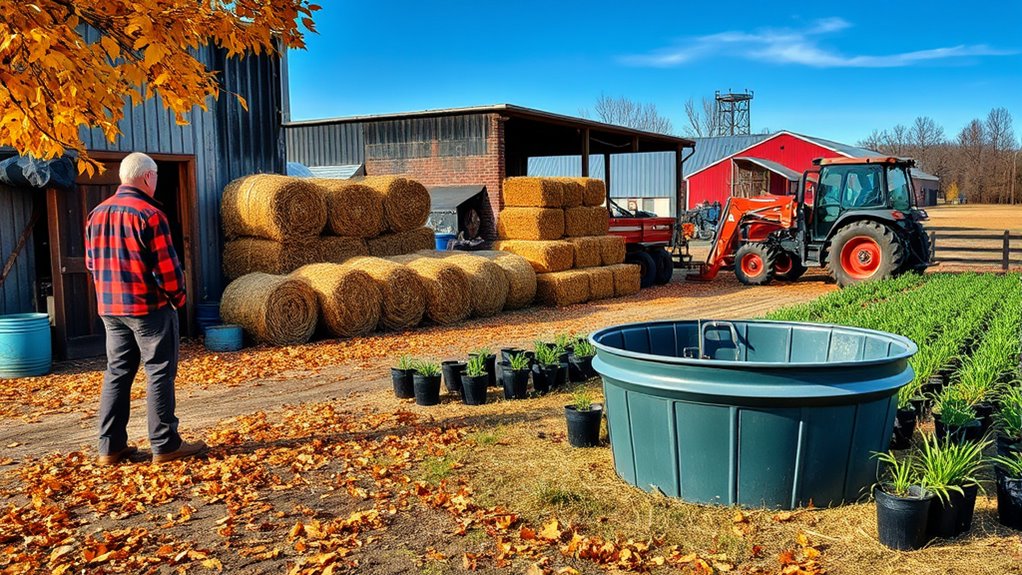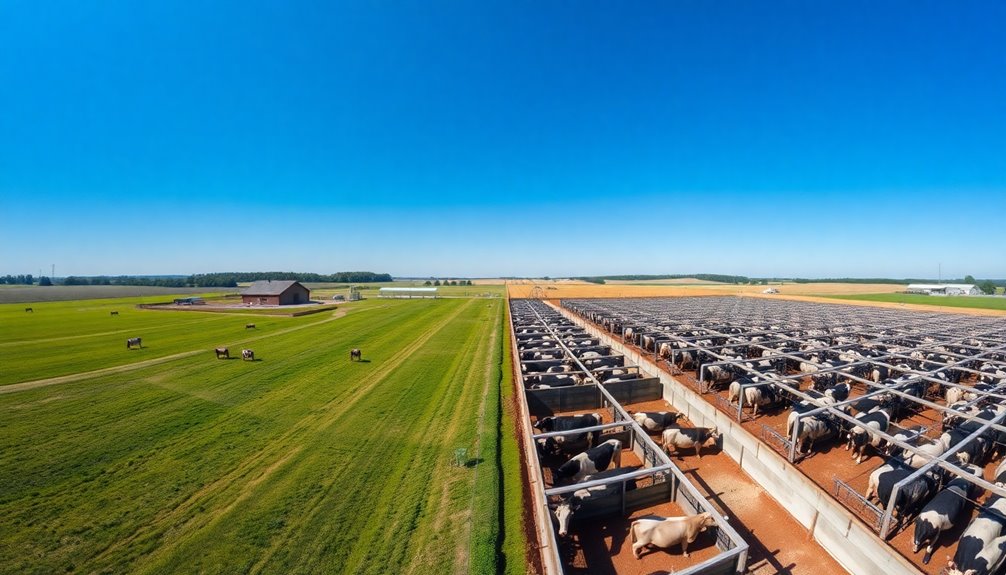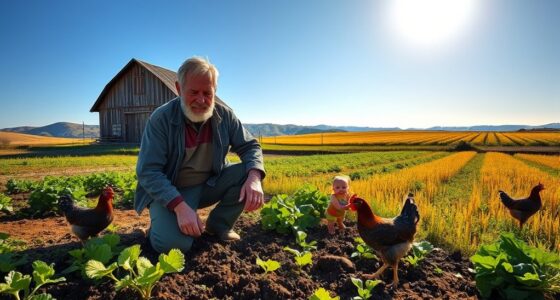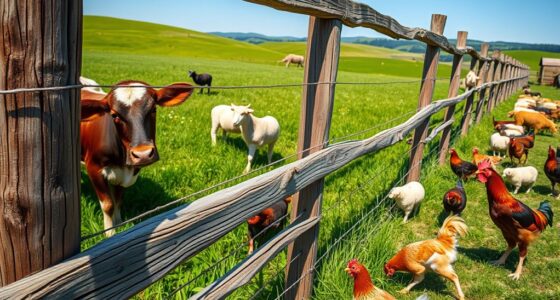To prepare your farm for winter, you should check and insulate water tanks, shelters, and fencing to withstand cold and snow. Make certain livestock have heated waterers, extra bedding, and proper ventilation to prevent frostbite and illness. Inspect your equipment and fire safety supplies, and prepare an emergency kit for storms. Staying proactive with weather updates and winter safety measures helps minimize disruptions. Keep exploring for detailed tips to make your farm winter-ready and resilient.
Key Takeaways
- Insulate water tanks, install reliable heaters, and ensure easy access to equipment for quick storm response.
- Provide well-insulated shelters, extra bedding, and heated waterers to keep livestock warm and hydrated.
- Monitor animals closely for cold stress, increase feed, and maintain dry bedding to support animal health.
- Prepare emergency kits, check fire safety equipment, and review winter safety protocols regularly.
- Inspect farm infrastructure, maintain sanitation, and ensure all tools and facilities are in optimal condition.

As winter approaches, it is essential to take proactive steps to protect your farm from harsh weather conditions. One of the most important aspects of winter preparation is guaranteeing you have the right winter equipment on hand. This includes sturdy, insulated water tanks to prevent freezing, reliable heaters for animal shelters, and weather-resistant fencing that can withstand snow and ice. You should also check your tools and machinery, making sure snow blowers, shovels, and salt spreaders are in good working order. Having winter equipment ready and accessible means you can respond quickly to any storms or cold snaps, minimizing disruptions and keeping your farm running smoothly.
Prepare your farm with insulated water tanks, heaters, and weather-resistant fencing for winter protection.
Livestock care becomes even more critical as temperatures drop. Your animals depend on your vigilance to stay healthy and comfortable during the winter months. Start by reviewing and improving your shelter setups to guarantee they’re well-insulated and draft-free. Adding extra bedding like straw or hay provides insulation and keeps your animals warm. Regularly check water supplies to prevent freezing; using heated waterers or anti-freeze solutions can help maintain access to fresh water, which is essential for livestock health. Monitoring your animals closely for signs of cold stress or frostbite, especially in vulnerable species like young calves, lambs, or older animals, is vital. Providing nutritional supplements or increased feed can help them generate more body heat, while ensuring they have access to dry, clean bedding reduces the risk of illness. Proper ventilation in shelters is equally important to prevent moisture buildup and respiratory issues, but it should be balanced with insulation to keep cold drafts out. Additionally, understanding the best modern toilet options for farm facilities can help maintain sanitation and prevent disease during the wet winter months. Staying informed about livestock health best practices can further reduce winter-related risks. Incorporating electricity production from bike generators into farm infrastructure can also provide alternative power sources for lighting or small appliances during outages, ensuring operations continue smoothly.
Furthermore, regularly inspecting your fire safety equipment, such as fire extinguishers and smoke detectors, is crucial to prevent accidents during winter, especially when heating sources are in use.
Finally, don’t forget to prepare yourself. Keep an emergency kit with extra warm clothing, flashlights, and batteries handy. Review your farm’s emergency plan and ensure all family or staff members are aware of winter safety protocols. By taking these steps—stocking up on winter equipment, prioritizing livestock care, and being ready for emergencies—you safeguard your farm against winter’s challenges. Staying proactive now ensures you’re prepared to handle whatever Mother Nature throws your way, allowing your farm to stay productive, safe, and resilient throughout the cold season.
Frequently Asked Questions
How Can I Prevent Winter Crop Damage Effectively?
To prevent winter crop damage, you should focus on frost protection and crop rotation strategies. Use row covers, mulch, or windbreaks to shield your crops from frost. Rotate crops annually to improve soil health and reduce vulnerability to pests and diseases. These practices help your crops withstand harsh winter conditions, ensuring better yields come spring. Proper frost protection combined with crop rotation keeps your farm resilient through the cold months.
What Are the Best Livestock Shelter Modifications for Cold Weather?
To keep your livestock warm in cold weather, focus on shelter modifications like adding thick livestock bedding to insulate and retain heat. Guarantee proper shelter ventilation to prevent moisture buildup and respiratory issues. You should also seal drafts and insulate walls and floors to maintain a consistent temperature. Regularly check and adjust bedding and ventilation systems, providing a comfortable, dry environment that minimizes cold stress and keeps your animals healthy all winter long.
How Do I Manage Winter Drainage Issues on My Farm?
Did you know that poor drainage can reduce crop yields by up to 50%? To manage winter drainage issues, you should implement effective drainage solutions like installing tile drains or creating raised beds. Focus on water management by grading fields to direct excess water away from livestock and crops. Regularly clear debris from drainage channels, and consider adding gravel or sand to improve water flow. These steps help prevent flooding and protect your farm during winter.
What Are Eco-Friendly Ways to Insulate Farm Buildings?
To insulate your farm buildings sustainably, opt for eco-friendly materials like sheep’s wool, recycled denim, or cellulose. These sustainable insulation options not only reduce environmental impact but also provide excellent thermal efficiency. You can also consider natural fiber insulation or straw bales for a more traditional, eco-friendly approach. By choosing sustainable insulation, you help lower your carbon footprint while keeping your farm warm and energy-efficient throughout winter.
When Should I Start Winterizing Farm Equipment?
You should start winterizing your farm equipment during seasonal maintenance, ideally before temperatures drop considerably. This ensures proper equipment storage and prevents damage from harsh weather. By early fall, you can check for worn parts, clean machinery, and apply protective coatings. Starting early gives you ample time to address any repairs, reducing downtime and ensuring your equipment stays in good condition throughout winter.
Conclusion
As winter approaches, your farm faces both challenges and opportunities. While the cold can threaten your crops and livestock, proper preparation offers protection and peace of mind. By taking proactive steps now, you guarantee resilience in the face of harsh weather. Embrace the quiet of winter just as you work to secure your farm’s future. With careful planning, you turn winter’s stillness into a season of strength and renewal.










